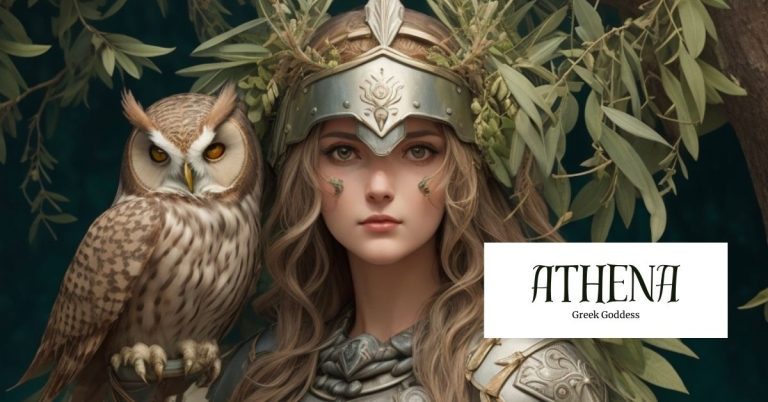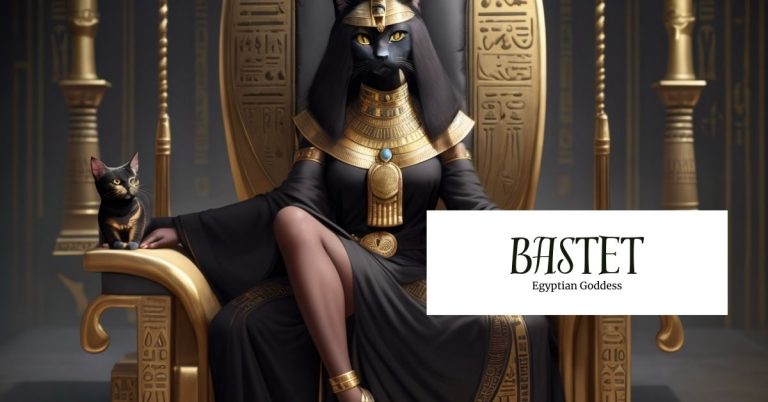Persephone: Goddess of Spring and Queen of the Underworld
Persephone, a prominent figure in Greek mythology, presents a fascinating and multifaceted persona. Revered as both the Goddess of Spring and the Queen of the Underworld, she embodies the intricate balance between life and death while exploring themes of growth, authority, and the cyclical nature of seasons. As a renowned Olympian deity, Persephone’s narrative offers insight into ancient beliefs and human perceptions of the natural world.
Overview of Persephone
Persephone’s essence is intricately woven into the very fabric of the changing seasons, heralding the arrival of spring as the goddess of new beginnings and fresh life. Celebrated for her indelible link to the blossoming landscapes, her influence extends far beyond the earthly realm. As the formidable Queen of the Underworld, she reigns alongside Hades (Wikipedia Contributors), her impact felt even in the depths of the afterlife.
Persephone is the offspring of Zeus, the king of Gods, and Demeter, the goddess of agriculture and fertility (“Persephone – New World Encyclopedia”). Holding dominion over agriculture and harvest, the name “Persephone” is derived from the archaic Greek term “pertho,” which signifies bringing forth and causing to fall. In addition to Persephone’s primary name, she is also known by the alternative appellation of Kore, which conveys her youthful and maidenly aspects, further enriching her complex identity (“Who Was Persephone in Greek Mythology? | Study.com”).
Source: Freepik
Titles
- Queen of the Underworld
- Goddess of Vegetation
- Bringer of Seasons
Abilities
Persephone’s multifaceted abilities are a testament to the vastness of her divine domains, seamlessly blending her roles as a goddess of the underworld and fertility. Her unique ability to bring forth new life and stimulate growth is evident in the blooming of flowers and revitalizing Earth’s landscapes. This innate power bestows upon her the capacity to guide the natural cycles of life, emphasizing her significance as a symbol of rejuvenation. In stark contrast, her connection to the underworld grants her the authority to govern the souls of the departed. This duality of power aptly exemplifies her sway over the complex interplay between existence and demise, a central theme in Greek mythology. Through her dual nature, Persephone bridges the realms of life and death, embodying the timeless cyclical forces that shape humanity’s understanding of existence (Cartwright).
Characteristics
The countenance and demeanor of Persephone beautifully reflect the harmonious balance between her dual dominions. As the Queen of the Underworld, she exudes an aura of regality and authority that commands reverence from mortals and gods alike. Draped in attire befitting her exalted station, she effortlessly assumes her mantle and establishes herself as an invincible force (“Persephone – New World Encyclopedia”).
Yet, in her identity as the goddess of spring, Persephone adorns herself with symbols of burgeoning life. Garlands of vibrant flowers and robes decorated with delicate petals become extensions of her essence, embodying growth and rebirth. These emblems vividly demonstrate her integral role in the cyclical rhythms of the natural world. The juxtaposition between her majestic portrayal in the underworld and her verdant adornments as a goddess of spring serves as a poignant reminder of her unique capacity to bridge the divide between life and death, illuminating the profound interconnectedness that weaves through her narrative (Cartwright).
Source: Xia Hunt
Traits
Persephone’s multifaceted personality traits offer a captivating glimpse into the intricate layers of her character. Often depicted as a compassionate and empathetic deity, her heart extends its warmth, particularly to the souls of the departed, reflecting a deep understanding of their plight (Cartwright). Her abduction by Hades served as a crucible for empathy, forging a profound connection with those who had experienced a similar fate. This shared experience deepened her compassion and allowed her to bridge the gap between the mortal realm and the world beyond.
Moreover, her benevolence is not confined solely to the realm of the dead. In the mortal world, she graces the land with blessings of fertility and growth, nurturing the crops that sustain humanity. As the bestower of life and the keeper of the underworld, Persephone beautifully encapsulates the duality of existence. This multifaceted nature also instilled within her a sense of resilience and wisdom, attributes that define her as a formidable deity (“Persephone – New World Encyclopedia”). Through her compassion, empathy, and strength, Persephone emerges as a figure whose essence embraces the complexities of the human experience.
Symbols
The mythos surrounding Persephone is abundant with symbols that carry profound layers of meaning, resonating with the multifaceted aspects of her identity (“Persephone”). Perhaps the most significant of these symbols is the pomegranate, renowned for its dual nature encompassing both seeds of life and the birth of death. This emblem encapsulates the essence of Persephone’s dual role as Queen of the Underworld and Goddess of Spring’s rejuvenation, providing a tangible representation of the perpetual cycle of existence. Thus, the pomegranate’s association with her is a poignant reminder of her pivotal place in the cosmic order and the intricate dance of life and death.
In addition to the pomegranate, the narcissus flower emerges as another significant symbol intertwined with Persephone’s narrative. This delicate bloom embodies themes of resurrection and renewal, aligning perfectly with her story of descending into the underworld and reemerging to oversee the rejuvenation of the Earth’s landscapes. Altogether, these symbols encapsulate the profound depth of Persephone’s story and her enduring significance within the tapestry of Greek mythology.
Source: Legend Bridal Designs
Festivals and Rituals
One of the most illustrious celebrations involving the veneration of Persephone is the Eleusinian Mysteries, a series of clandestine rituals that celebrated the veneration of Demeter and Persephone. This well-known ceremony portrayed the myth of Persephone’s abduction by the king of the underworld, Hades, from her mother, Demeter, in three phases: the descent, the search, and the ascent. The central theme of the Mysteries was the ascent of Persephone and her reunion with her mother (Wikipedia Contributors). The Mysteries were held in Eleusis and provided a sacred space for initiates to delve into the intricate cycles of life, death, and rebirth. The enigmatic rituals, enriched with symbolic practices and profound teachings, allowed participants to grasp the profound interplay between light and shadow, mirrored in the goddess’s narrative.
Another notable festival that paid homage to Persephone was the Thesmophoria, a vibrant celebration exploring fertility and harvest themes. This festival uniquely honored Persephone’s role in the abundant growth of crops, and women engaged in various rituals and activities that celebrated her influence over the bounties of the Earth (“Who Was Persephone in Greek Mythology? | Study.com”). The Thesmophoria reaffirmed her status as a deity intricately linked to the sustenance of the land and stood as a testament to the enduring reverence held for Persephone, underscoring her mythos’s profound impact on shaping ancient Greek religious observances.
Source: Study Abroad in Greece
Legends associated with Persephone
Persephone is a figure of great mythological and mystical significance. As the embodiment of the delicate balance between life and death, light and darkness, she has been the subject of countless legends throughout history. From her birth to her abduction and its impact on her mother, Persephone’s enduring presence and influence have captivated scholars and enthusiasts alike. Her story continues to resonate with many, serving as a reminder of the complex and often intricate nature of the human experience.
Origin story
The Orphic “Rhapsodic Theogony” unravels the genesis of Persephone through a series of unsettling events. In this narrative, Zeus, the sovereign of the gods, is depicted in a disconcerting light as his desires take a deviant turn toward his mother, Rhea. Driven by his yearning for Rhea, Zeus relentlessly pursues her, despite her resistance, causing her to transform into a serpent to evade his advances. Overcoming Rhea’s resistance, he rapes her, resulting in the birth of Persephone, and after this Rhea became Demeter.
However, Persephone’s birth reveals a deformity that incites fear, prompting Rhea/Demeter’s maternal instincts to falter. Overwhelmed by the creation she had brought forth, Rhea/Demeter retreats, leaving Persephone to navigate the complexities of her existence in solitude. However, soon after, within the sanctuary of her mother’s abode, Persephone sought refuge and was shielded by the ever-watchful Curetes (Wikipedia Contributors).
Source: Quora
The Mythical Tale of Persephone’s Abduction and the Intricate Relationship with Hades
The tale of Hades and Persephone has captivated audiences for many generations. According to legend, Hades was smitten with the beautiful Persephone and sought permission from Zeus to abduct her, disregarding her mother Demeter’s objections. Persephone was gathering flowers in a meadow with her handmaidens Oceanides, Artemis, and Pallas when Hades suddenly appeared and seized her (Wikipedia Contributors), taking her by force through an aperture in the earth and into his realm in the underworld (“Persephone”).
While many may view Persephone’s abduction as a coercive act, the truth is far more complex. Different interpretations of the myth suggest that there may have been a consensual union between the two, indicating a mutual understanding or arrangement (“Who Was Persephone in Greek Mythology? | Study.com”). Persephone’s role as the Queen of the Underworld further complicates the traditional notions of captor and captive, with her sharing rulership over the realm of the dead with Hades (Cartwright).
Persephone’s transformation and self-discovery are central themes of the abduction narrative. Her time in the underworld allowed her to evolve from an innocent maiden to a powerful and influential deity. Her connection to Hades allowed her to exercise dominion over the souls of the deceased, shaping the afterlife and reinforcing the idea that their relationship is far more complex than a simple abduction (“Persephone – New World Encyclopedia”). Overall, the myth of Hades and Persephone is a story of transformation, power, and self-discovery. While it may have been viewed as a mere abduction in the past, modern interpretations have shed new light on the complexities of their relationship and the significance of Persephone’s role as the Queen of the Underworld.
Source: Daily Art magazine
Persephone’s Homecoming: A Story of Reunion and Rebirth
The myth of Persephone’s time spent in the underworld as the Queen alongside Hades is a profound narrative of transformation and growth. However, her absence from the world above significantly affected the Earth. Demeter, her mother, and the fertility goddess mourned deeply, causing the Earth to wither and lead to the onset of winter (Wikipedia Contributors). According to some versions of the myth, Demeter’s grief prompted her to halt the fertility of the Earth, leading to widespread suffering. To restore balance, Zeus intervened and negotiated with Hades. As a result, Persephone was permitted to return to the surface world for a portion of the year, signifying spring’s arrival and the Earth’s reinvigoration (“Persephone – New World Encyclopedia”).
The story of Persephone’s return to the surface world is often associated with her mother’s joyous reunion and the subsequent renewal of life. The thawing of the Earth, the blossoming of flowers, and the revitalization of crops mirror the goddess’s return and influence as a deity of growth and abundance (“Persephone”). This cyclical dance of descent and ascent highlights Persephone’s dual role as a bridge between realms and a symbol of the ever-changing seasons.
Source: Legend Bridal Designs
Influences of other religions/cultures on Persephone
Persephone’s mythology extends beyond the confines of Greek culture, resonating throughout the broader spectrum of ancient Mediterranean religious practices (Cartwright). Interestingly, her story bears a striking resemblance to other deities in distant mythologies. For example, in Mesopotamian mythology, the goddess Inanna embarks on an underworld journey that mirrors Persephone’s descent, suggesting a universal transformation motif through the realm of the dead (“Who Was Persephone in Greek Mythology? | Study.com”).
Similarly, the Egyptian goddess Isis, renowned for her role in resurrecting her husband Osiris, shares thematic parallels with Persephone’s narrative of rebirth and renewal (“Persephone – New World Encyclopedia”). These parallels serve as evidence of cross-cultural exchanges of ideas, demonstrating the capability of mythic motifs to transcend cultural boundaries and enhance the perception of the goddess. Persephone’s story becomes a universal emblem of the human experience, a bridge connecting diverse civilizations through the shared themes of life’s cyclical rhythms and the eternal interplay of darkness and light (“Persephone”).
Modern appearances
Persephone’s timeless allure continues to captivate in the modern era through an array of artistic and literary interpretations, attesting to her enduring resonance (“Persephone – New World Encyclopedia”). As a symbol of transformation and empowerment, she thrives in contemporary literature, films, and artworks exploring her complex character’s depths:
- Margaret Atwood’s “The Penelopiad” reimagines the myth from the perspective of Penelope, incorporating Persephone’s narrative into the broader tapestry of ancient tales.
- A.S. Byatt’s “The Virgin in the Garden” The narrative explores the interweaving of mythology and reality using Persephone’s mythic threads.
- Lore Olympus is a contemporary romantic webcomic that presents a modern adaptation of the tale of the abduction of Persephone.
These adaptations and inspirations underscore Persephone’s abiding relevance in the human psyche, demonstrating how her tale of cycles, growth, and resilience continues to evolve and thrive in the modern creative landscape.
Source: Amazon
Final thoughts
The legends of Persephone stand as a testament to this goddess’s enduring allure and complexity. Through her origin story and the varied interpretations of her myth, her influence transcends cultures and time. Her tale is a poignant reminder of the delicate balance between life and death, light and darkness. It ultimately illuminates the human experience and the profound mysteries that lie within it.
References
Cartwright, Mark. “Persephone.” World History Encyclopedia, 24 Mar. 2016, www.worldhistory.org/persephone/.
“Persephone.” Mythopedia, mythopedia.com/topics/persephone.
“Persephone – New World Encyclopedia.” Www.newworldencyclopedia.org, www.newworldencyclopedia.org/entry/Persephone.
“Who Was Persephone in Greek Mythology? | Study.com.” Study.com, 2019, study.com/academy/lesson/who-was-persephone-in-greek-mythology.html.
Wikipedia Contributors. “Persephone.” Wikipedia, Wikimedia Foundation, 9 Dec. 2018, en.wikipedia.org/wiki/Persephone.







